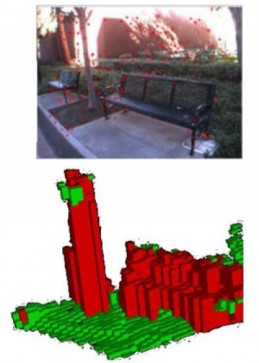Robotic guide vest and echolocation steer sightless walkers
May 26, 2011

Simultaneous Localization and Mapping (SLAM) software analyzes data from stereo camera views (above) to create 3-D renderings of the scene (below) and map a path through it (credit: USC Viterbi School of Engineering)
A design for a robotic vision-based mobility aid for the visually impaired has been further developed by a group of University of Southern California engineering researchers. It could soon supplement canes and guide dogs.
The system uses cameras worn on the head connected to PCs that use Simultaneous Localization and Mapping (SLAM) software to build maps of the environment and identify a safe path through obstacles.
This route information is conveyed to the user through a guide vest, which includes four micro motors located on an individual’s shoulder and waist that vibrate like cell phones.
A prototype was shown at the 2010 International IEEE Engineering in Medicine and Biology Society (EMBS) Conference, and more recently at the 2011 meeting of Association for Research in Vision and Opthalmology.
Blind use visual part of brain to “hear” ecolocation clicks
Researchers at the University of Western Ontario’s Centre for Brain and Mind have shown that blind people use the “visual” part of their brain to process the clicks and echoes used in using echolocation. These “blind echolocators” have learned to make clicks with their mouths and to use the returning echoes from those clicks to sense their surroundings.
The researchers first made recordings of the clicks and their very faint echoes using tiny microphones in the ears of the blind echolocators as they stood outside and tried to identify different objects such as a car, flag pole, or tree. The researchers then played the recorded sounds back to the echolocators while their brain activity was being measured in a fMRI brain scanner.
They found that when the echolocation recordings were played back to the blind echolocators, not only did they perceive the objects based on the echoes, but they also showed activity in those areas of their brain that normally process visual information in sighted people — but not the areas that process auditory information.
According to the World Health Organization, 39 million people worldwide are totally blind and a much larger number, 284 million, are visually impaired.
In the United States, according to the American Foundation for the Blind, 109,000 visually impaired people use long white canes to get around, and about 7,000 nationwide use a guide dog.
Ref: Thaler L, Arnott SR, et al., Neural Correlates of Natural Human Echolocation in Early and Late Blind Echolocation Experts, PLoS ONE 6(5): e20162. doi:10.1371/journal.pone.0020162
